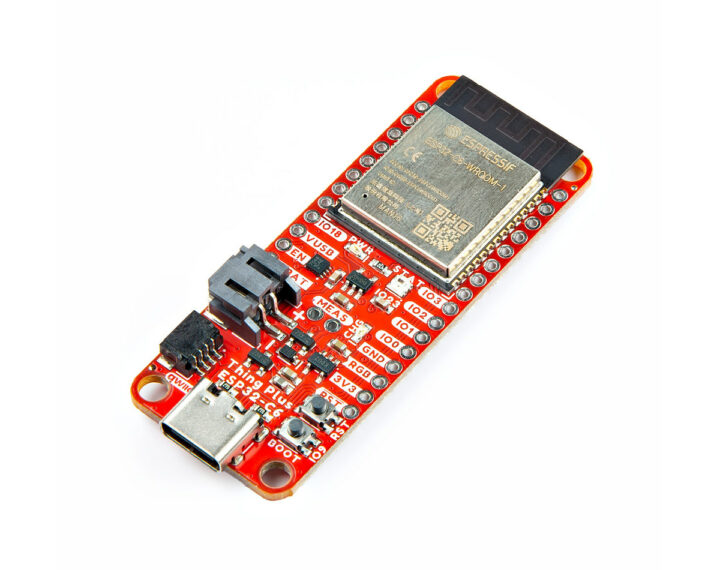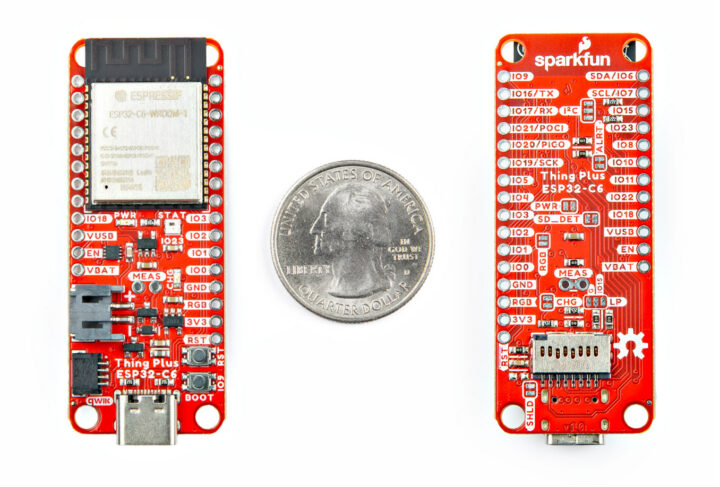SparkFun has launched yet another ESP32-C6 board with the “Thing Plus – ESP32-C6” based on the ESP32-C6-WROOM-1-N16 module with 16MB flash and a PCB antenna and range of I/Os and power options.
The board features 28 through holes with up to 23 multi-function GPIOs and a Qwicc connector for expansion, and supports 5V or LiPo battery power through respectively a USB-C port a 2-pin JST connector combined with a charging chip, and a fuel gauge.
SparkFun Thing Plus – ESP32-C6 specifications:
- Wireless module – ESP32-C6-WROOM-1-N16
- Storage – MicroSD card slot
- USB – 1x USB Type-C port for power and programming
- Expansion
- 12-pin + 16-pin headers with
- 23x multifunctional GPIOs
- Up to 7x 12-bit ADC channels
- Up to 2x UART channels (with flow control)
- 1x Low Power UART, 1x I2C, 1x Low Power I2C
- LED PWM
- 1x I2S Channel
- 4-pin Qwiic connector
- 12-pin + 16-pin headers with
- Misc
- LEDs for Power (Red), charging status (Yellow), and system status (Blue)
- 1x WS2812 RGB LED
- BOOT and RESET buttons
- Power Supply
- 5V via USB-C port
- 2-pin JST connector for LiPo battery
- MCP73831 battery charger – Charge Rate: 213mA @ 3.3V
- MAX17048 fuel gauge – I2C Address: 0x36
- Dimensions – 64.8 x 22.9 mm; 2x mounting holes
The ESP32-C6 board is open-source hardware with Sparkfun providing the hardware design files (EAGLE and Gerber files), some datasheets, and documentation on GitHub. I’m not sure who thought it was a good idea but the documentation is distributed as MD files and provides instructions to get started with Arduino programming.
The market for ESP32-C board is starting to get crowded starting from the cheap WeAct ESP32-C6 to DFRobot FireBeetle 2 also supporting LiPo batteries, or even Olimex ESP32-C6-EVB with more features for home automation, and many others. The “Sparkfun Things Plus – ESP32-C6” board adds another option with a larger flash (16MB) than most competitors and compatibility with Qwiic modules and the Things Plus form factor.
The company is selling the board for $19.95 plus shipping on its store.
Thanks to TLS for the tip.

Jean-Luc started CNX Software in 2010 as a part-time endeavor, before quitting his job as a software engineering manager, and starting to write daily news, and reviews full time later in 2011.
Support CNX Software! Donate via cryptocurrencies, become a Patron on Patreon, or purchase goods on Amazon or Aliexpress








Nice, C6 has 16 MB of address space for memory mapped (executable) flash, C3 has only 8 MB.
I assume the fuel guage is used to read battery level?
If so, a pretty good base for many mini-projects
Has anyone used any of the recent ESP32 chips like the C6 for BLE, Zigbee or Matter battery-powered applications?
The big issue with the original ESP32 chips was that to conserve power, you had to power down nearly everything, and every time you needed to do even minimal radio activity, you had to wake up and boot the full ESP32, which takes time and power, making the ESP32 unsuitable for such applications (as opposed to what the nRF5 series can do). The ULP was pretty limited and could not do much that was radio-related.
Did that change with the more recent chips? Or is “battery-powered” and “wireless” still a no-no in the ESP32 world?
I’m looking for an integrated CPU+Zigbee board with Arduino libraries for Zigbee